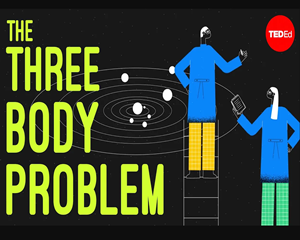In 2009, two researchers ran a simple experiment.
2009年,两名研究人员做了个简单实验。
They took everything we know about our solar system and calculated where every planet would be up to 5 billion years in the future.
他们基于我们对太阳系所有的了解,计算了50亿年后每颗行星的位置。
To do so they ran over 2,000 numerical simulations with the same exact initial conditions except for one difference:
为此,他们进行了2000多次数值模拟,所有初始条件保持不变,除了一个参数值:
the distance between Mercury and the Sun, modified by less than a millimeter from one simulation to the next.
水星到太阳的距离在每次后续模拟中减少不足1毫米的距离差。
Shockingly, in about 1 percent of their simulations, Mercury's orbit changed so drastically that it could plunge into the Sun or collide with Venus.
令人震惊的是,大约1%的模拟中,水星轨道发生了巨大变化,它可能会一头扎进太阳或与金星相撞。
Worse yet, in one simulation it destabilized the entire inner solar system.
更糟糕的是,一次模拟实验中,水星打破了整个内太阳系的稳定。
This was no error; the astonishing variety in results reveals the truth that our solar system may be much less stable than it seems.
模拟实验没有出错;模拟结果的惊人变化揭示了这样一个事实:我们的太阳系可能远没有看上去的那么稳定。
Astrophysicists refer to this astonishing property of gravitational systems as the n-body problem.
对于引力系统的这种惊人特性,天体物理学家称之为“N体问题”。
While we have equations that can completely predict the motions of two gravitating masses, our analytical tools fall short when faced with more populated systems.
虽然我们可以用方程式来完美预测两个引力物体的运动,但面对包含更多物体的系统时,我们的分析工具就捉襟见肘了。
It's actually impossible to write down all the terms of a general formula that can exactly describe the motion of three or more gravitating objects. Why?
实际上,根本不可能写出一个包含所有变量的通用公式,来精确地描述三个或更多引力物体的运动。为什么?
The issue lies in how many unknown variables an n-body system contains.
这实际上取决于一个N体系统究竟包含多少个未知变量。
Thanks to Isaac Newton, we can write a set of equations to describe the gravitational force acting between bodies.
多亏了艾萨克·牛顿,我们才可以写出一套方程来描述作用于两个物体间的引力。
However, when trying to find a general solution for the unknown variables in these equations, we're faced with a mathematical constraint:
但当我们试图找出这些方程中未知变量的通解时,则面临着数学上的限制:
for each unknown, there must be at least one equation that independently describes it.
对每个未知变量,必须至少有一个单独描述它的方程。
Initially, a two-body system appears to have more unknown variables for position and velocity than equations of motion.
起初,和运动方程相比,二体系统似乎有更多关于位置和速度的未知变量。
However, there's a trick: consider the relative position and velocity of the two bodies with respect to the center of gravity of the system.
然而,技巧在这里:要考虑两个物体相对于系统重心的相对位置和速度。
This reduces the number of unknowns and leaves us with a solvable system.
这样就减少了未知数的数量,使其变成一个可解的系统。

With three or more orbiting objects in the picture, everything gets messier.
若有三个或更多绕轨道运行的物体,一切就会变得复杂得多。
Even with the same mathematical trick of considering relative motions, we're left with more unknowns than equations describing them.
即使同样使用考虑相对运动的数学技巧,我们面临的未知变量的数量也多于描述它们的方程。
There are simply too many variables for this system of equations to be untangled into a general solution.
对于这个方程组来说,变量太多,无法得到一个通解。
But what does it actually look like for objects in our universe to move according to analytically unsolvable equations of motion?
不过在现实中,宇宙中物体是如何遵循这些无解运动方程运动的呢?
A system of three stars -- like Alpha Centauri -- could come crashing into one another or, more likely, some might get flung out of orbit after a long time of apparent stability.
由三颗恒星组成的系统--像半人马座--可能会相互碰撞,或者,更有可能的是,表面看似稳定了很长时间后,有些恒星就会被甩出轨道。
Other than a few highly improbable stable configurations, almost every possible case is unpredictable on long timescales.
除了少数极不可能的稳定配置外,从较长的时间尺度来看,几乎所有可能情况都不可预测。
Each has an astronomically large range of potential outcomes, dependent on the tiniest of differences in position and velocity.
基于位置和速度的最微小差异,每项潜在的结果都可能存在于一个很大的天文数学范围里。
This behaviour is known as chaotic by physicists, and is an important characteristic of n-body systems.
这种行为被物理学家称为“混沌”,也是N体系统的一个重要特征。
Such a system is still deterministic -- meaning there's nothing random about it.
这样的系统仍然有确定性--即它没有任何随机性。
If multiple systems start from the exact same conditions, they'll always reach the same result.
如果多个系统初始条件完全相同,它们总是会得到相同的结果。
But give one a little shove at the start, and all bets are off.
但如果初始条件稍有改变,结果将难以预料。
That's clearly relevant for human space missions, when complicated orbits need to be calculated with great precision.
对人类太空任务来说,这显然关系重大,因为复杂的轨道需要非常精确的计算。
Thankfully, continuous advancements in computer simulations offer a number of ways to avoid catastrophe.
庆幸的是,计算机模拟技术的持续进步为避免灾难提供了大量方法。
By approximating the solutions with increasingly powerful processors, we can more confidently predict the motion of n-body systems on long time-scales.
利用日益强大的处理器计算出更接近的解决方案,我们可以更自信地预测出N体系统在长时间尺度上的运动。
And if one body in a group of three is so light it exerts no significant force on the other two, the system behaves, with very good approximation, as a two-body system.
如果三体系统中有一个质量很轻,它对另外两个物体施力轻微,这个三体系统的运行则非常近似于二体系统。
This approach is known as the "restricted three-body problem."
这种方法称为“限制性三体问题”。
It proves extremely useful in describing, for example, an asteroid in the Earth-Sun gravitational field, or a small planet in the field of a black hole and a star.
实际证明,这种方法非常有用,例如,用来描述地球-太阳引力场内的小行星,或黑洞和恒星引力场内小一点的行星。
As for our solar system, you'll be happy to hear that we can have reasonable confidence in its stability for at least the next several hundred million years.
至于我们的太阳系,你大可不必担心,至少在未来几亿年内它都会很稳定,我们对此有充分的信心。
Though if another star, launched from across the galaxy, is on its way to us, all bets are off.
但若一颗恒星从银河系另一边出发,正向我们飞来,那么一切后果都将难以预料。


